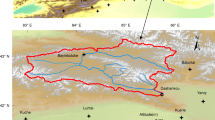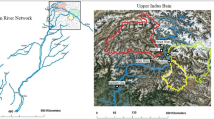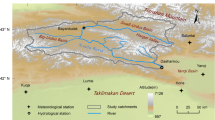Abstract
To quantitatively assess the impact of climate variability on streamflow in an ungauged mountainous basin is a difficult and challenging work. In this study, a hybrid model combing downscaling method based on earth data products, back propagation artificial neural networks (BPANN) and weights connection method was developed to explore an approach for solving this problem. To validate the applicability of the hybrid model, the Kumarik River and Toshkan River, two headwaters of the Aksu River, were employed to assess the impact of climate variability on streamflow by using this hybrid model. The conclusion is that the hybrid model presented a good performance, and the quantitative assessment results for the two headwaters are: (1) the precipitation respectively increased by 48.5 and 41.0 mm in the Kumarik catchment and Toshkan catchment, and the average annual temperature both increased by 0.1 °C in the two catchments during each decade from 1980 to 2012; (2) with the warming and wetting climate, the streamflow respectively increased 1.5 × 108 and 3.3 × 108 m3 per decade in the Kumarik River and the Toshkan River; and (3) the contribution of the temperature and precipitation to the streamflow, which were 64.01 ± 7.34, 35.99 ± 7.34 and 47.72 ± 8.10, 52.26 ± 8.10%, respectively in the Kumarik catchment and Toshkan catchment. Our study introduced a feasible hybrid model for the assessment of the impact of climate variability on streamflow, which can be used in the ungauged mountainous basin of Northwest China.












Similar content being viewed by others
References
Allen MR, Frame DJ, Huntingford C, Jones CD, Lowe JA (2009) Warming caused by cumulative carbon emissions towards the trillionth tonne. Nature 458:1163–1166
Bai L, Chen Z, Xu J, Li W (2015) Multi-scale response of runoff to climate fluctuation in the headwater region of Kaidu River in Xinjiang of China. Theor Appl Climatol 2016:1–10. doi:10.1007/s00704-015-1539-2
Brown ME, Racoviteanu AE, Tarboton DG et al (2014) An integrated modeling system for estimating glacier and snow melt driven streamflow from remote sensing and earth system data products in the Himalayas. J Hydrol 519:1859–1869. doi:10.1016/j.jhydrol.2014.09.050
Chen Y, Cui W, Li W, Zhang Y (2003) Utilization of water resources and ecological protection in the Tarim River. Acta Geographica Sinica 58:215–222. doi:10.11821/xb200302008
Chen Y, Takeuchi K, Xu C, Chen Y, Xu Z (2006) Regional climate change and its effects on river runoff in the Tarim Basin, China. Hydrol Process 20:2207–2216. doi:10.1002/hyp.6200
Chen F, Yuan Y, Wen W et al (2012) Tree-ring-based reconstruction of precipitation in the Changling Mountains, China, since A.D.1691. Int J Biometeorol 56:765–774. doi:10.1007/s00484-011-0431-8
Chen Y, Xu C, Chen Y, Liu Y, Li W (2013) Progress, challenges and prospects of eco-hydrological studies in the Tarim River Basin of Xinjiang, China. Environ Manage 51:138–153. doi:10.1007/s00267-012-9823-8
Chen Y, Li Z, Fan Y, Wang H, Deng H (2015) Progress and prospects of climate change impacts on hydrology in the arid region of northwest China. Environ Res 139:11–19. doi:10.1016/j.envres.2014.12.029
Duethmann D, Bolch T, Farinotti D et al (2015) Attribution of streamflow trends in snow and glacier melt-dominated catchments of the Tarim River, Central Asia. Water Resour Res 51:4727–4750. doi:10.1002/2014WR016716
Fischer A (2015) How to determine the unique contributions of input-variables to the nonlinear regression function of a multilayer perceptron. Ecol Modell 2015:60–63
Fu AH, Chen YN, Li WH, Li BF, Yang YH, Zhang SH (2013) Spatial and temporal patterns of climate variations in the Kaidu River Basin of Xinjiang, Northwest China. Quat Int 311:117–122. doi:10.1016/j.quaint.2013.08.041
Gan TY (2000) Reducing vulnerability of water resources of Canadian prairies to potential droughts and possible climatic warming. Water Resour Manag 14:111–135
Georgakakos KP, Graham NE, Modrick TM, Murphy MJ, Shamir E, Spencer CR, Sperfslage JA (2014) Evaluation of real-time hydrometeorological ensemble prediction on hydrologic scales in Northern California. J Hydrol 519:2978–3000. doi:10.1016/j.jhydrol.2014.05.032
Getirana ACV, Espinoza JCV, Ronchail J, Rotunno Filho OC (2011) Assessment of different precipitation datasets and their impacts on the water balance of the Negro River basin. J Hydrol 404:304–322. doi:10.1016/j.jhydrol.2011.04.037
Guo Y, Shen Y (2016) Agricultural water supply/demand changes under projected future climate change in the arid region of northwestern China. J Hydrol 540:257–273. doi:10.1016/j.jhydrol.2016.06.033
Infanti JM, Kirtman BP (2016) North American rainfall and temperature prediction response to the diversity of ENSO. Clim Dyn 46:3007–3023. doi:10.1007/s00382-015-2749-0
Kendall MG (1948) Rank correlation methods. Oxford Univ Pr, England
Li B, Chen Y, Shi X, Chen Z, Li W (2013) Temperature and precipitation changes in different environments in the arid region of northwest China. Theor Appl Climatol 112:589–596. doi:10.1007/s00704-012-0753-4
Liston GE, Elder K (2006) A meteorological distribution system for high-resolution terrestrial modeling (MicroMet). J Hydrometeorol 7:217–234. doi:10.1175/JHM486.1
Liu Z, Xu Z, Charles SP, Fu G, Liu L (2011) Evaluation of two statistical downscaling models for daily precipitation over an arid basin in China. Int J Climatol 31:2006–2020. doi:10.1002/joc.2211
Liu Y, Yang W, Qin C, Zhu A (2016) A review and discussion on modeling and assessing agricultural best management practices under global climate change. J Sustain Dev 9:245
Ma Z, Kang S, Zhang L, Tong L, Su X (2008) Analysis of impacts of climate variability and human activity on streamflow for a river basin in arid region of northwest China. J Hydrol 352:239–249. doi:10.1016/j.jhydrol.2007.12.022
Mahmood R, Babel MS (2013) Evaluation of SDSM developed by annual and monthly sub-models for downscaling temperature and precipitation in the Jhelum basin, Pakistan and India. Theor Appl Climatol 113:27–44. doi:10.1007/s00704-012-0765-0
Mann HB (1945) Nonparametric tests against trend. Econometrica J Econom Soc 1945:245–259
Neupane RP, White JD, Alexander SE (2015) Projected hydrologic changes in monsoon-dominated Himalaya Mountain basins with changing climate and deforestation. J Hydrol 525:216–230. doi:10.1016/j.jhydrol.2015.03.048
Ohmura A (2012) Enhanced temperature variability in high-altitude climate change. Theor Appl Climatol 110:499–508. doi:10.1007/s00704-012-0687-x
Olden JD, Jackson DA (2002) Illuminating the “black box”: a randomization approach for understanding variable contributions in artificial neural networks. Ecol Modell 154:135–150. doi:10.1016/S0304-3800(02)00064-9
Olden JD, Joy MK, Death RG (2004) An accurate comparison of methods for quantifying variable importance in artificial neural networks using simulated data. Ecol Modell 178:389–397
Pachauri RK, Allen MR, Barros VR et al (2014) Climate change 2014: synthesis report. Contribution of Working Groups I, II and III to the fifth assessment report of the Intergovernmental Panel on Climate Change. IPCC, Switzerland
Pettitt AN (1979) A non-parametric approach to the change-point problem. J R Stat Soc 28:126–135
Pohlert T (2016) Non-Parametric Trend Tests and Change-Point Detection. CC BY-ND 4.0. http://creativecommons.org/licenses/by-nd/4.0/. Accessed 28 May 2017
Raup B, Racoviteanu A, Khalsa SJS, Helm C, Armstrong R, Arnaud Y (2007) The GLIMS geospatial glacier database: a new tool for studying glacier change. Glob Planet Change 56:101–110. doi:10.1016/j.gloplacha.2006.07.018
Reuter HI, Nelson A, Jarvis A (2007) An evaluation of void-filling interpolation methods for SRTM data. Int J Geogr Inf Sci 21:983–1008
Rolland C (2003) Spatial and seasonal variations of air temperature lapse rates in alpine regions. J Clim 16:1032–1046
Sen PK (1968) Estimates of the regression coefficient based on Kendall’s Tau. J Am Stat Assoc 63:1379–1389
Xu C, Chen Y, Li W, Chen Y (2006) Climate change and hydrologic process response in the Tarim River Basin over the past 50 years. Chin Sci Bull 51:25–36. doi:10.1007/s11434-006-8204-1
Xu C, Chen Y, Hamid Y, Tashpolat T, Chen Y, Ge H, Li W (2009) Long-term change of seasonal snow cover and its effects on river runoff in the Tarim River basin, northwestern China. Hydrol Process 23:2045–2055. doi:10.1002/hyp.7334
Xu J, Chen Y, Li W et al (2013a) Combining BPANN and wavelet analysis to simulate hydro-climatic processes—a case study of the Kaidu River, North-west China. Front Earth Sci 7:227–237. doi:10.1007/s11707-013-0354-2
Xu J, Chen Y, Li W, Nie Q, Hong Y, Yang Y (2013b) The nonlinear hydro-climatic process in the Yarkand River, northwestern China. Stoch Environ Res Risk Assess 27:389–399. doi:10.1007/s00477-012-0606-9
Xu Z, Liu P, Liu W (2013c) Automated statistical downscaling in several river basins of the Eastern Monsoon region, China. IAHS AISH Publ 2013:81–85
Xu C, Chen Y, Chen Y, Zhao R, Ding H (2013d) Responses of surface runoff to climate change and human activities in the arid region of Central Asia: a case study in the Tarim River Basin, China. Environ Manage 51:926–938. doi:10.1007/s00267-013-0018-8
Xu J, Chen Y, Li W, Nie Q, Song C, Wei C (2014) Integrating wavelet analysis and BPANN to simulate the annual runoff with regional climate change: a case study of Yarkand River, Northwest China. Water Resour Manag 28:2523–2537. doi:10.1007/s11269-014-0625-z
Xu J, Chen Y, Bai L, Xu Y (2016a) A hybrid model to simulate the annual runoff of the Kaidu River in northwest China. Hydrol Earth Syst Sci 20:1447–1457. doi:10.5194/hess-20-1447-2016
Xu J, Chen Y, Li W, Liu Z, Tang J, Wei C (2016b) Understanding temporal and spatial complexity of precipitation distribution in Xinjiang, China. Theor Appl Climatol 123:321–333. doi:10.1007/s00704-014-1364-z
Yang YH, Li WH, Wei WS, Hao XM, WAN M, LI H (2009) Discrepancy analysis of the climate changes among mountain, plain, oasis and desert in an inland river basin in the northern slopes of the Tianshan Mountains—a case study in the Sangong river basin. J Glaciol Geocryol 31:1094–1100
Yang Y, Chen Y, Li W, Yu S, Wang M (2012) Climatic change of inland river basin in an arid area: a case study in northern Xinjiang, China. Theor Appl Climatol 107:143–154. doi:10.1007/s00704-011-0467-z
Yang D, Gao B, Jiao Y, Lei H, Zhang Y, Yang H, Cong Z (2015) A distributed scheme developed for eco-hydrological modeling in the upper Heihe River. Sci China Earth Sci 58:36–45. doi:10.1007/s11430-014-5029-7
Yatagai A, Yasunari T (1994) Trends and decadal-scale fluctuations of surface air temperature and precipitation over China and Mongolia during the recent 40 year period (1951–1990). J Meteorol Soc Jpn 72:937–957
Zhang X, Zuo Q (2015) Analysis of water resource situation of the Tarim River basin and the system evolution under the changing environment. J Coastal Res 73:9–16. doi:10.2112/SI73-003.1
Zhao J, Xu Z, Singh VP (2016) Estimation of root zone storage capacity at the catchment scale using improved Mass Curve Technique. J Hydrol 540:959–972. doi:10.1016/j.jhydrol.2016.07.013
Acknowledgements
This work was supported by the Open Foundation of the State Key Laboratory of Desert and Oasis Ecology, Xinjiang Institute of Ecology and Geography, Chinese Academy of Sciences (No. G2014-02-07); and the National Natural Science Foundation of China (41630859).
Author information
Authors and Affiliations
Corresponding author
Rights and permissions
About this article
Cite this article
Wang, C., Xu, J., Chen, Y. et al. A hybrid model to assess the impact of climate variability on streamflow for an ungauged mountainous basin. Clim Dyn 50, 2829–2844 (2018). https://doi.org/10.1007/s00382-017-3775-x
Received:
Accepted:
Published:
Issue Date:
DOI: https://doi.org/10.1007/s00382-017-3775-x




